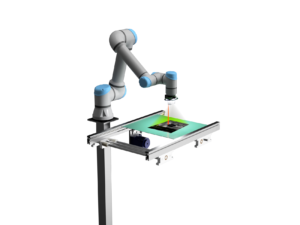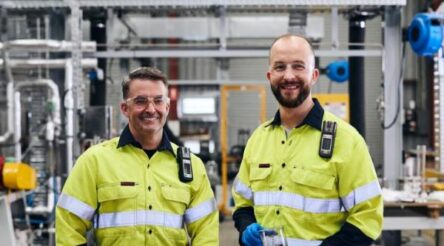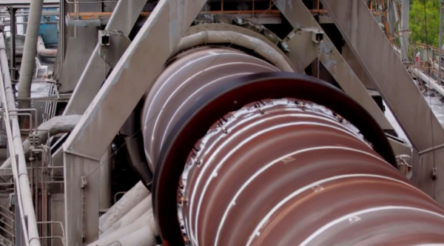Robotics adoption matters: collaborating with robots

In day three of @AuManufacturing’s Robotics adoption matters series Matthew Adams discusses collaborative robots and where they can help SME manufacturers.
Until recently, automation in Australian manufacturing has been reserved for large scale industrialised manufacturing. These organisations have either engaged external companies to implement automation or they’ve had the technical skills to do it in-house. Now, with the emergence of cheaper and more collaborative robots, aka ‘Cobots’, smaller organisations can reap the benefits of increased automation but many companies are unaware of where to start.
A new generation
Unlike their predecessors, these ‘Cobots’ are:
- more responsive to their environment and so don’t require the same level of infrastructure such as safety cages
- easily programmable by someone that doesn’t have a technical background
- more adaptable to different programming frameworks through open programming interfaces
- more flexible in how they can be used to perform different tasks traditionally reserved for non-cobot robotics
So there is great potential for SMEs to solve problems using Cobots but at the moment there is a knowledge and culture gap that’s preventing this. There is still a perception in Australia that robots are prohibitively expensive, require specialised knowledge to deploy, and are difficult to run and modify but this isn’t necessarily the case.
Where Cobots shine
Cobots are ideal for doing repetitive work that people typically don’t like or aren’t good at— including work that may be ergonomically challenging. When people do repetitive tasks that aren’t pleasant or interesting they usually get bored—and when people become bored they make simple mistakes which can cost a lot. Robots are perfect for these types of jobs.
Essentially, Cobots can help increase throughput as well as quality and job satisfaction. There’s been an assumption for decades now that if you’re a manufacturer in Australia and you want to create a large production run, say 5000 units or more—that you’re going to need to do that overseas. But the existence of these new robots means that we should be able to bring some of this manufacturing work back to our shores. For some companies, the dream is to have production happening around the clock. Cobots can facilitate this by working at night when humans would prefer not to. Other companies are simply seeking further business efficiencies. Striking the right balance between humans and machines is a topical problem that Cobots can help to solve.
Identifying where Cobots can help
Knowing how and when to use robots requires a deep knowledge of the industry that you’re working in but also a deep knowledge of emerging technologies. The first piece of advice I’d give to manufacturers is to look at production tasks that take a lot of time, that are repetitive, and where precision and attention to detail are critical. These are the low hanging fruit, so to speak, for the application of Cobots. Companies can then consider more novel applications. Return on investment and cultural fit obviously need to be considered, the latter because cobots become part of your team.
 The problem is that manufacturers often don’t know enough about Cobots to leverage their power. I think this needs to be addressed on a few fronts. For example, there could be more effort made to connect companies with Cobot makers but there is a larger need for community around this technology. For instance, if Australian manufacturers can see examples from other companies that might fit what they’re doing, they could better recognise opportunities for automation. This sort of knowledge sharing will facilitate innovation and accelerate the industry.
The problem is that manufacturers often don’t know enough about Cobots to leverage their power. I think this needs to be addressed on a few fronts. For example, there could be more effort made to connect companies with Cobot makers but there is a larger need for community around this technology. For instance, if Australian manufacturers can see examples from other companies that might fit what they’re doing, they could better recognise opportunities for automation. This sort of knowledge sharing will facilitate innovation and accelerate the industry.
With that said, the Advanced Manufacturing Growth Centre (AMGC) is doing an excellent job of encouraging automation from the bottom up, least of all by providing financial support to companies for R&D into automation. As an example, we recently received a grant from them to develop an AR (Augmented Reality) based Quality Control and Inspection system for Printed Circuit Board manufacturing. A six-axis Cobot was the first choice as the centerpiece of our solution. This project idea was born out of the recognition that we could improve in-line inspection for PCB fabrication in several ways, through the use of AR, AI (Artificial Intelligence) and most of all… Cobots.
Current inspection systems are very expensive and difficult to adjust once established in a production line. They also require a lot of hands-on human interaction. The system we are pioneering will be modular so it can be placed anywhere in the production line or used as an offline production evaluation system. The Cobot arm itself will move around the PCB, scanning it for defects and highlighting production issues via an AR headset. It will be a completely new Industry 4.0 connected solution that can quickly identify and access design files associated with the board from a central cloud repository.
This kind of solution is an example of a Cobot application that is only conceivable because of the convergence of various recently developed technologies. As Tekt Industries is a specialist in the business of electronics manufacture, we were able to recognise this opportunity for automation. Other manufacturing industries will be able to recognise different opportunities based on their own expertise, resulting in a more productive and exciting workplace in which Cobots are part of the team.
Picture: Tekt Industries’ planned inspection system for electronics manufacture—featuring a cobotic arm.
Matthew Adams is CEO and founder at Tekt Industries.
 @AuManufacturing’s Robotics adoption matters series is brought to you with the support of the Advanced Robotics for Manufacturing Hub.
@AuManufacturing’s Robotics adoption matters series is brought to you with the support of the Advanced Robotics for Manufacturing Hub.
Subscribe to our free @AuManufacturing newsletter here.
Topics Manufacturing News Technology
@aumanufacturing Sections
Analysis and Commentary Awards Defence Manufacturing News Podcast Technology Videos










